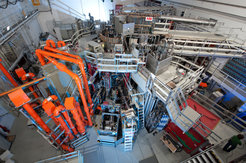Nuclear Fusion Award 2017 to IPP scientist
François Ryter honoured for plasma experiments on transition to the high-confinement regime
The Nuclear Fusion Award 2017 is honouring experimental physicist Dr. François Ryter of Max Planck Institute for Plasma Physics (IPP) at Garching. The annually awarded prize is in recognition of outstanding work published in Nuclear Fusion, the most cited journal in fusion research.

The prize is presented to authors whose publications have had the greatest influence in the two years following publication.
François Ryter received the Nuclear Fusion Award 2017 for his paper on experiments in Garching’s ASDEX Upgrade tokamak. This reports investigations conducted by Ryter with the ASDEX Upgrade team to clarify the transition of the plasma to the high-confinement regime, H-regime for short. It is characterised by particularly good thermal insulation of the hot, magnetically confined plasma. The international ITER fusion test reactor, now being built at Cadarache, France, and future fusion power plants will be operating in the H-regime.
The paper published by Ryter in 2014, “Experimental evidence for the key role of the ion heat channel in the physics of the L-H transition”, shows that of the various factors accounting for the transition from the poor low-confinement to the favourable high-confinement regime it is the thermal flux of the ions at the plasma edge that plays the key role. This makes it possible to determine more exactly the heating power needed to trigger the transition. “This is important for better understanding of the future operation of ITER and other experiments”, states US research scientist Dr Rich Hawryluk, chair of the Board of Editors and prize jury of the Nuclear Fusion journal. The prize, endowed with 2,500 US dollars, is to be presented at the next IAEA Fusion Energy Conference in October 2018 in Ahmadabad, India. Click here for the prize-winning publication of Ryter et al.
